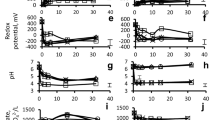Abstract
Mineral mining generates acidic, saline, metal-rich mine waters, often referred to as acid mine drainage (AMD). Treatment of AMD and recovering saleable products during the treatment process are a necessity since water is, especially in South Africa, a scarce commodity. The aim of the study presented here was to investigate the effect of zero valent iron (Fe0) on the biological removal of sulphate from AMD in batch reactors. The performance of the reactors was assessed by means of sulphate reduction, chemical oxygen demand (COD), volatile fatty acid (VFA) utilisation and volatile suspended solids (VSS) concentration. To this end, three batch reactors, A, B and C (volume 2.5 L), were operated similarly with the exception of the addition of grass cuttings and iron filings. Reactors A and B received twice as much grass (100 g) as C (50 g). Reactor A received no iron filings to act as a control, while reactors B and C received 50-g iron filings for the experimental duration. The results showed that Fe0 appears to provide sustained sulphate removal when sufficient grass substrate is available. In reactors A and C, sulphate removal efficiency was higher when the COD concentration was lower due to utilisation. In reactor B, sulphate removal efficiency was accompanied by an accumulation of COD as hydrogen (H2) provided by the Fe0 was utilised for sulphate reduction. Furthermore, these results showed the potential of Fe0 to enhance the participation of microorganisms in sulphate reduction.







Similar content being viewed by others
References
Santos, R., Machado, R., Joana Neiva Correia, M., & Carvalho, J. R. (2004). Treatment of acid mine water. Mineral Engineering, 17, 225–232.
Neculita, C. M., Zaguty, G. J., & Busiere, B. (2007). Passive treatment of acid mine drainage in bioreactors using sulfate-reducing bacteria: critical review and research needs. Journal of Environmental Quality, 36, 1–16.
Greben, H. A., Baloyi, L. M., & Venter, S. N. (2007). Grass cellulose as cost effective energy source for biological sulphate removal. Water SA, 33(5), 729–735.
Greben, H. A., Baloyi, J., Sigama, J., & Venter, S. N. (2009). Bioremediation of sulphate rich mine effluents using grass cuttings and rumen microorganisms. Journal of Geochemical Exploration, 100, 163–168.
Gazea, B., Adam, K., & Kontopoulos, A. (1996). A review of passive systems for the treatment of mine drainage. Mineral Engineering, 9, 23–42.
Barnes, S. P., & Keller, J. (2003). Cellulosic waste degradation by rumen-enhanced anaerobic digestion. Water Science and Technology, 48(4), 155–162.
Rinzema, A., & Lettinga, G. (1988). The effect of sulfide on the anaerobic degradation of propionate. Environmental Technology Letters, 9(2), 83–88.
Omil, F., Lens, P., Visser, A., Pol, L. W. H., & Lettinga, G. (1998). Long-term competition between sulfate reducing and methanogenic bacteria in UASB reactors treating volatile fatty acids. Biotechnology and Bioengineering, 57(6), 676–685.
Choi, E., & Rim, J. M. (1991). Competition and inhibition of sulfate reducers and methane reducers in anaerobic treatment. Water Science Technology, 23, 1259–1264.
Fernandez Sanchez, J. M., Sawvel, E. J., & Alvarez, P. J. J. (2004). Effect of Fe0 on quantity on the efficiency of integrated microbial Fe0 treatment processes. Chemosphere, 54, 823–829.
Liamleam, W., & Annachhatre, A. P. (2007). Electron donors for biological sulphate reduction. Biotechnology Advances, 25, 452–463.
Xin, Y., Yong, K., Duujong, L., & Ying, F. (2008). Bioaugmented sulphate reduction using enriched anaerobic microflora in the presence of zero valent iron. Chemosphere, 73, 1436–1441.
Abd-el-malek, Y., & Rizk, S. G. (1958). Counting of sulphate reducing bacteria in mixed bacterial populations. Nature, 182, 538.
American Public Health Association. (1985). Standard methods for the examination of water and wastewater (16th ed.). Washington DC: American Public Health Association.
Scherer, M. M., Richter, S., Valentine, R. L., & Alvarez, P. J. J. (2000). Chemistry and microbiology of permeable reactive oxygen barriers for in situ ground water clean-up. Critical Reviews in Environmental Science and Technology, 30(3), 363–411.
Mulopo, J., Greben, H., Sigama, J., Radebe, V., Mashego, M., & Burke, L. (2011). The relationships between sulphate reduction and COD/VFA utilisation using grass cellulose as carbon and energy sources. Applied Biochemistry and Biotechnology, 163(3), 393–403.
Lens, P. N. L., van den Bosch, M. C., Hulshoff Pol, L. W., & Lettinga, G. (1998). Effect of staging on volatile fatty acid degradation in a sulphidogenic granular sludge reactor. Water Research, 32, 1178–1192.
Visser, A. (1995). The anaerobic treatment of sulphate containing wastewater. PhD thesis, Wageningen Agricultural University, Wageningen, The Netherlands.
Author information
Authors and Affiliations
Corresponding author
Rights and permissions
About this article
Cite this article
Mulopo, J., Schaefer, L. Effect of the Addition of Zero Valent Iron (Fe0) on the Batch Biological Sulphate Reduction Using Grass Cellulose as Carbon Source. Appl Biochem Biotechnol 171, 2020–2029 (2013). https://doi.org/10.1007/s12010-013-0500-z
Received:
Accepted:
Published:
Issue Date:
DOI: https://doi.org/10.1007/s12010-013-0500-z




